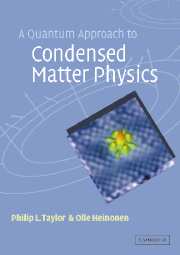Book contents
- Frontmatter
- Contents
- Preface
- Chapter 1 Semiclassical introduction
- Chapter 2 Second quantization and the electron gas
- Chapter 3 Boson systems
- Chapter 4 One-electron theory
- Chapter 5 Density functional theory
- Chapter 6 Electron–phonon interactions
- Chapter 7 Superconductivity
- Chapter 8 Semiclassical theory of conductivity in metals
- Chapter 9 Mesoscopic physics
- Chapter 10 The quantum Hall effect
- Chapter 11 The Kondo effect and heavy fermions
- Bibliography
- Index
Chapter 1 - Semiclassical introduction
Published online by Cambridge University Press: 05 June 2012
- Frontmatter
- Contents
- Preface
- Chapter 1 Semiclassical introduction
- Chapter 2 Second quantization and the electron gas
- Chapter 3 Boson systems
- Chapter 4 One-electron theory
- Chapter 5 Density functional theory
- Chapter 6 Electron–phonon interactions
- Chapter 7 Superconductivity
- Chapter 8 Semiclassical theory of conductivity in metals
- Chapter 9 Mesoscopic physics
- Chapter 10 The quantum Hall effect
- Chapter 11 The Kondo effect and heavy fermions
- Bibliography
- Index
Summary
Elementary excitations
The most fundamental question that one might be expected to answer is “why are there solids?” That is, if we were given a large number of atoms of copper, why should they form themselves into the regular array that we know as a crystal of metallic copper? Why should they not form an irregular structure like glass, or a superfluid liquid like helium?
We are ill-equipped to answer these questions in any other than a qualitative way, for they demand the solution of the many-body problem in one of its most difficult forms. We should have to consider the interactions between large numbers of identical copper nuclei – identical, that is, if we were fortunate enough to have an isotopically pure specimen – and even larger numbers of electrons. We should be able to omit neither the spins of the electrons nor the electric quadrupole moments of the nuclei. Provided we treated the problem with the methods of relativistic quantum mechanics, we could hope that the solution we obtained would be a good picture of the physical reality, and that we should then be able to predict all the properties of copper.
But, of course, such a task is impossible. Methods have not yet been developed that can find even the lowest-lying exact energy level of such a complex system. The best that we can do at present is to guess at the form the states will take, and then to try and calculate their energy.
- Type
- Chapter
- Information
- A Quantum Approach to Condensed Matter Physics , pp. 1 - 25Publisher: Cambridge University PressPrint publication year: 2002



